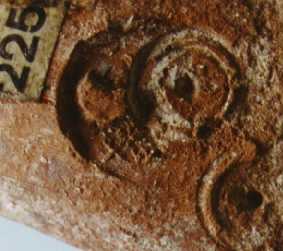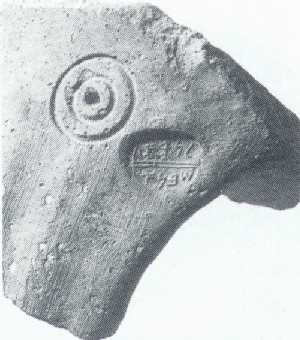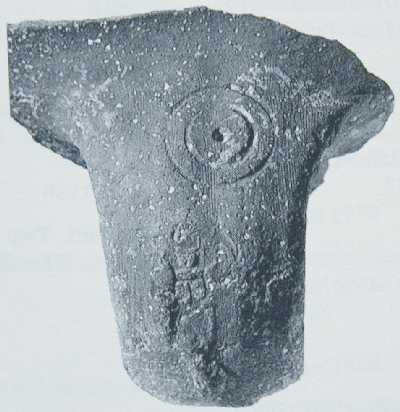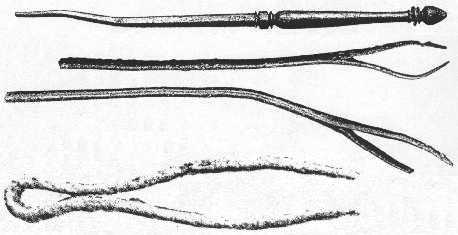
 |
LMLK Concentric Circle Marks |
|
LMLK Home Biblical Accounts NonBiblical Accounts Theories HBRN MMST SUKE ZYF Generic x (cannot classify) 2-Top 2-Divided 2-Undivided 4-Cursory 4-Lapidarist Jars Personal Seals Incisions Paleography Typologies Corpus Stratigraphy Geography Displays Publications Credits Updates 
|
"Some handles have in addition a stamp consisting of two concentric circles with a central dot. . . . but it seems useless to give statistics . . ."----David Diringer, 1953 In addition to LMLK stamps, at least 288 handles of Type 484 also have incised Circle marks:138 handles with only Circle marks (3 singles; 135 pairs) 135 handles with Circle marks & LMLK stamps (3 singles [G2T, H2D, M2D]; 132 pairs) 003 handles with Circle marks & Personal stamps (all pairs) 012 handles with Circle marks that may or may not have LMLK stamps LMLK inscription words when Circle marks are present: 23 HBRN 15 MMST 05 SUKE 12 ZYF 09 Generic 71 x (cannot classify by inscription word) LMLK inscription styles when Circle marks are present: 10 Two-Winged Top-Registers 47 Two-Winged Divided 00 Two-Winged Undivided 74 Two-Winged (cannot classify by inscription style) 01 Four-Winged Cursory 01 Four-Winged Lapidarist 02 cannot classify by inscription or icon LMLK stamp orientations when Circle marks are present: 00 1:00 00 2:00 20 3:00 12 4:00 02 5:00 01 6:00 01 7:00 03 8:00 24 9:00 03 10:00 00 11:00 04 12:00 66 unknown Provenance for handles with Circle marks: 139 Jerusalem 41 Gibeon (el-Jib) 35 Ramat Rahel (Beth-Haccerem?) 19 Tell en-Nasbeh 17 Khirbet el-Burj 15 unknown 5 Gibeah (Tell el-Ful) 4 Lachish (Tell ed-Duweir) (mistakenly reported by others as only 3) >1 Gezer 1 Arad 1 Beth Shemesh (Ain Shems or Tell er-Rumeileh) 1 Beth Zur (Khirbet et-Tubeiqa) 1 Bethlehem 1 En Gedi (Tel Goren) 1 Jericho (Tell es-Sultan) 1 Khirbet es-Samrah 1 Moresheth-Gath (Tell ej-Judeideh or Tel Goded) 1 Timnah (Tel Batash) Note: They've also been reported from Tell Beit Mirsim & Azekah (Tell Zakariya) but without photos or descriptions of the handles, it's impossible to confirm whether they're Type 484 handles or one of the other pottery forms unrelated to the LMLK enterprise. Outer diameters based on 76 specimens with a pair: Maximum: 21mm (0.83") Average: 16mm (0.64") Minimum: 12mm (0.48") Diameters based on 5 specimens with a single circle: Maximum: 17mm (0.65") Average: 13mm (0.53") Minimum: 11mm (0.43") Inner diameters based on 73 specimens with a pair: Maximum: 14mm (0.55") Average: 10mm (0.40") Minimum: 07mm (0.28") See the table at the bottom of this page for details of the handles excavated from Gibeon, & refer to the Theories page for interpretations of their meaning. Since no jars with Circle marks have been restored yet, it's impossible to know whether they were ever made exclusively on jars without LMLK or Personal stamps, nor is it possible to know for certain whether all 4 handles of a jar were consistently marked. Out of all these handles with Circle marks, only two have been excavated from a stratum identified with the late 8th-century Assyrian conquest (not sealed by it)--Shiloh's excavation at Jerusalem, where one other was found in the early 7th-century stratum, & 28 were from later strata. One handle with Circles was found in the 7th-century stratum at Timnah, one at Khirbet es-Samrah, & one at Arad. The handles found at Ramat Rahel, Gibeah, Beth Zur, & En Gedi are in strata disputed as either the late 8th or early 7th century. The majority of handles with Circles at Gibeon were found in the upper third of the Great Pool. It's important to remember that the earliest stratified stamps from x4x & x2U LMLK seal types preceded the late 8th-century Assyrian conquest, the earliest majority of Rosette stamps preceded the late 7th-century Babylonian conquest, & the Circle marks (along with the x2D & x2T LMLK stamps) reside sometime in between those 2 groups of stamps. Click here to see the most common form of Circles incised between the LMLK stamp & the jar joint with the inner circle approximately midway between the central anchor dot & the outer circle; the magnified view shows a clear distinction between the colored external ware & the inner gray core, which indicates incision after firing. Click here for a less common form with very close diameters. Whoever incised the Circles was usually careful to avoid damaging the icon by overlapping it; click here to see a rare exception. Two examples of tri-circle incisions were excavated at Gibeon but neither is on a LMLK-type handle: one small cooking pot incised after firing (field # 341; stamp # 95; museum ID# 62-30-1120) & one giant pithos handle incised before firing (field # 828; P# 911; museum ID# 62-30-1292). Neither of these has a central anchor dot.





|
|
|
Number of visits: |
This page was created on September 21, 2002, & last updated on December 25, 2011 |